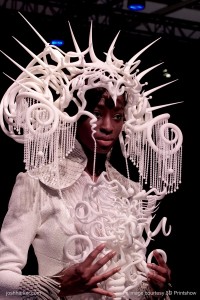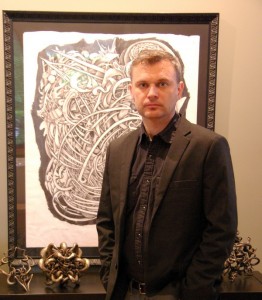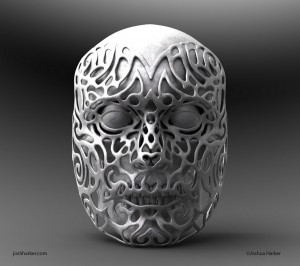aNewDomain.net — Our art-meets-tech correspondent Pat Meier-Johnson interviewed a revolutionary in the 3D printing world — Joshua Harker. She reports on the world of art and 3D printing and conducts an in-depth interview with the pioneer himself.
“My inspiration, vision, execution and statements are not decided by machines, any more than stone or metal guide my hand. ” — Joshua Harker.

Quixotic Divinity Headdress by Joshua Harker. Image credit: 3D Printshow
Take a look at Joshua Harker’s Quixotic Headdress — you can easily lose yourself in the depth and complexity of his meandering, organic works. Harker is one of the most-recognized artists to pioneer digital sculpture and three-dimensional printing.
In the ’80s he created surrealist automatism drawings inspired by the loose, spontaneous twists and shapes of great artists like Miro, Dali and Picasso. But how could he turn his 2D drawings into 3D works? He knew he needed to build his expertise in CAD and prototyping, so he became a commercial sculptor and designer of toys and special effects, developing everything from motorcycles to medical equipment.
How It Works
3D printing provides the tools to create complex objects — sculpting items that are nearly impossible to carve out of wood or create in clay. With 3D printing techniques you can prototype a design, endlessly refine or change the design, and manufacture the prototype in materials like plastic, ceramics or sterling silver.
Designers and engineers are creating body parts, home décor items and automotive parts, among many others. An entirely new universe is opening up for fine artists to realize their vision in 3D. And, just as giclees did for two dimensional art, 3D printing allows the artist to conduct short manufacturing runs, placing many works in many hands, or simply create a single work of art.
3D Printing: Art or Technology?
I interviewed Joshua Harker about his vision, the materials and technology he uses and the popularization of this art form.
It was Harker’s CAD expertise in the commercial realm that enabled him to turn his 2D organic drawings into his first virtual “Tangle” sculpture. Depending on how mechanical or organic the work is, he uses Blender, Solidworks, 3ds Max, ZBrush, Meshlab and other software to realize his vision.
At the start, he used a gel-based 3D printer. Finding that method unable to support the mass of his objects, Harker moved on to EOS manufactured SLS (Selective Laser Sintering) machines. This printing process fuses polyamide nylon/glass powder together using a scanning laser beam to build an object layer upon layer, and then uses a lost wax process to manufacture the work in bronze.
[acx_slideshow name=”Joshua Harker 3D Art Process”]
While his Tangles was met with moderate enthusiasm, it was Kickstarter that really put Harker on the map. His Lacy Skulls became the most-funded sculpture project the site has ever had — to this day. He has given TEDX talks and will judge the Sketchfab and Adobe Photoshop 3D print design contest at the 3D PrintShow in New York, this February 13-15 (2014).

3D artist Joshua Harker in front of one of his Tangle drawings.
The Interview
Pat Meier-Johnson: An item has to be visualized well before the form is printed. Do you work any differently preparing for the process than if you were working in another medium?
Joshua Harker: The piece is fully visualized digitally before print stage and I’ve worked so long in the medium that I have an intuition about what will physically work. So given that, it is a closer jump from work to physical piece right at the end than say a sketch that I’m going to do in clay or wood. Part of what brought me to 3D printing was the ability to work spontaneously. I know that might sound ridiculous but the tools and way I work now are hardly different to me than drawing or sculpting in clay… only with different tools if that makes sense. This is a recent scenario and more about modeling software, however. Only in the last few years has everything gotten to a point where I can work the way I do.
PMJ: What steps do you go through, right from the start, to develop a new work of art?
JH: I typically get inspired by something then the wheels start turning. Occasionally I do some sketches but often I start right in on the digital sculpture. So, depending on what the piece is, I just follow my vision and refine it as it grows in front of me … no differently than when I work in clay. I’ve got some conceptual themes that I’m working on that are more about visualizing forms a certain way. This is a bit more pragmatic but still very much a “throw it at the wall and see what sticks” kind of approach. Once I feel a piece is done I need to prep for print and do all the techy boring stuff like scaling, decimation, exporting, validation, etc. I hate that part but it’s just how the medium works. It’s actually gotten easier over the last few years. Hoping that trend continues.

Delicated Ingress in 3D printed polyamide. Image credit: Joshua Harker)
3D printing gave Harker freedom of geometry. He found that no traditional mediums could hold up to the intensity and physical-property requirements of developing his organic drawings three-dimensionally. In the early 2000s he made his first “Tangle,” bringing two eras together to create forms that could not be made any other way. He used 3D-printed patterns for a process that has been around for a millennia, lost wax casting.
JH: These pieces are credited with being the first forms to break the design and manufacturability threshold … meaning nothing like them technically could or had been created before. This has been considered to be a landmark event in the chronology of 3d printing and history of sculpture … Lucky me to be alive and making art in this era.
PMJ: How much of 3D printing is art and how much is science?
JH: Ah, the can of worms right there. All of 3D printing is science or tech. I say, ‘No art in the heart of a machine, no heart in the art of a machine.’ All the art happens before the machine has anything to do with it. The printers are no more than a way to three-dimensionally document the work. Not really any different than a photograph, lithograph, molding and casting process, etc … simply a tangible way of reproducing the piece. Whether you choose to make one or a million copies does not change the work, only the scarcity. The only arguments in support of scarcity as a definition of art are those concerned with valuation and there are no good arguments that say just because a piece is worth more that makes it better. As 3D-printer technology, holographic projections, haptic experiences, and who-knows-what-else further develop, there will be other and possibly even-better ways for artists to share their multi-dimensional visions. My inspiration, vision, execution and statements are not decided by machines, any more than stone or metal guide my hand. As amazing and accurate as it is, there is a unique struggle to make the medium do what you intend as much as with anything else. There are pieces that are nothing more than visualized code, algorithms and formulas. Not my bag personally, but in the hands of the right artist who’s to say that can’t be part of the new toolset? A great thing about this technology is the necessity for us to readdress our preconceived notions and definitions of what art is.

Self Portrait (Photo Credit: Joshua Harker)
Outer space, inner space, and the limits of our imaginations. Literally we will be able to create off planet, we will be able to create at atomic and molecular scales, we will be able to create with materials too dangerous to look at. The sky is the limit … no pun intended.
Interested in trying 3D printing yourself? A good place to start is at a Meetup of 3D-printing enthusiasts.
For aNewDomain.net, I’m Pat Meier-Johnson.
Based in the San Francisco Bay Area, Pat Meier-Johnson is a senior commentator at aNewDomain.net covering the nexus of technology and art. Look for her stories, interviews, videos and photos about the people and events where digital and analog creative arts meet. Contact her at patmeierjohnson@anewdomain.net.













I’m not sure what to think just yet. The tech is really cool, though.
I mean, I wanna look at this as a sculpture or something, but yet it’s “printed”
-RAP, II
Thank you for this very interesting article and although Joshua Harker says that his inspiration, vision, execution and statements are not decided by machines, any more than stone or metal guide his hand, this is ingenuous and I see this differently. I say that inspiration and vision are guided and influenced by the processes, materials and tools we select to use. Although machines do not create the vision, they do present the different affordances and constraints that artists select, explore, and push to the limits to develop their art. Sculptors do this working with stone, metal, etc.. They work to just within those boundaries that they have discovered in their explorations and experimentation. By working long and hard to build up their expertise and tacit knowledge, they are able to push the boundaries further. 3D printers are machines and 3D printing technologies are no different from any other process. Joshua does go on to say that he has worked so long in the medium that he has an intuition about what will physically work, i.e he now has such embedded tacit knowledge, and is so familiar with digital technologies, that he doesn’t have to think about, and so doesn’t have to acknowledge, how the different software he uses and the different printing processes inspire and influences his visions, statements and artwork. These are not exactly decided by machines but isn’t this pretty close?
Thanks for your insight, Ann Marie. I think it’s a bit of a horse race. Artists and innovators dream. Technology enables execution of those dreams. When you don’t have to worry about technological constraints you can dream even bigger.
Hello Pat, all technology has constraints and it is the wise, talented and skilful artists who work with and exploit the constraints to realise and push their dreams. This way dreams can grow bigger.